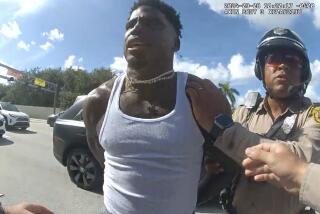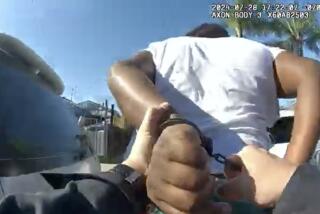LAPD Officers Reportedly Taunted King in Hospital : Investigation: They told victim that they hit ‘home runs’ off him, according to grand jury transcript.
Jeering at Rodney G. King in a hospital emergency room, Los Angeles police officers flippantly remarked that “we played a good game of hardball” and “we hit quite a few home runs” after smashing their batons over his body, according to transcripts of grand jury testimony.
The transcripts also show that a California Highway Patrol officer advised the Los Angeles County Grand Jury that Los Angeles officers violated commonly practiced police policies by wielding the batons on King’s head.
“They tell you not to use it” on someone’s head, CHP Officer Melanie Singer testified, “ . . . because of the damage-causing effect it can have.” The only exception, she added, would be if “you are in a survival situation where it’s life or death.”
And Joseph Callahan, a former Los Angeles County sheriff’s deputy who now is a recognized expert on police use of force, testified that, given what he viewed on a videotape of the beating, there was “absolutely” no justification for the Los Angeles police officers to hit King anywhere with their batons.
“There is no assaultive behavior that would justify a baton use and, in this case, a continued baton use,” he said.
The testimony, taken over four days last week behind the grand jury’s closed doors, was used by the panel to support its indictment of Los Angeles Police Sgt. Stacey Koon and Officers Laurence M. Powell, Timothy E. Wind and Theodore J. Briseno.
The officers had been scheduled for arraignment Friday in Superior Court for their roles in the March 3 beating, but that hearing was postponed until Tuesday when their attorneys told the judge they were not ready to proceed.
After the short hearing, Deputy Dist. Atty. Terry L. White told reporters, “We’re going to present more evidence to the grand jury next week.” But the prosecutor declined to elaborate on whether additional criminal charges may be forthcoming against the two dozen other officers from the Police Department, the CHP and the Los Angeles Unified School District who stood by while King was struck up to 56 times.
Also on Friday, Police Chief Daryl F. Gates, who is standing up to repeated calls for his resignations, spoke before a luncheon of the Jewish Federation Council of Greater Los Angeles, a coalition of 500 member organizations, only one of which has called for his removal.
He reiterated his statements of Thursday night to the Public Relations Society of America that he would consider retiring “when confidence has been restored” in the department. But he said the statement did not mean he would retire soon.
He also told the Friday luncheon that removing the civil service protections over the job of chief would lead to widespread corruption in city government, similar to that in New York and Chicago. He also dismissed the idea of a citizen review board to investigate police misconduct, saying complaints already are examined by the Police Commission.
And he said that he had the full backing of his department. “You only have leadership when you have a followership,” Gates declared. “I’ve got it and I’m staying.”
The vow received applause from four people in the audience of about 150.
Later, a group of black police officers announced its support for Gates. Representatives of the Oscar Joel Bryant Foundation, which has 900 members in the department, released a written statement Friday evening that condemned the beating of King but praised the police chief. Gates has provided “strong leadership to the finest law enforcement agency in this nation,” the statement said.
In the grand jury transcript, which was obtained Friday by The Times, Carole Denise Edwards and Lawrence Davis, emergency room nurses at Pacifica Hospital in Sun Valley, described how some of the officers sarcastically referred to King’s beating as though it were a baseball game.
The nurses said the taunting began when King mentioned that he worked as an usher at Dodger Stadium.
“What section do you work in?” Edwards said one of the officers asked King. “I want to make sure I don’t go into that section.”
An officer then said to King, “We played a little baseball tonight, didn’t we?”
“What do you mean?” King asked.
“We played a little hardball tonight, and you lost.”
Davis recalled that one of the officers said, “We played a pretty good hard game ourselves, didn’t we?”
The nurse said King responded, “Yeah, yeah, you guys had a pretty good game. You played pretty good hardball tonight.”
And one of the officers remarked, “Yeah, you know, we played a good game of hardball tonight, and we hit quite a few home runs, didn’t we?”
Edwards also described how two officers were near King when hospital staffers asked how King was hurt. “One officer that was standing next to me patted his baton,” she said, “and the other one sort of held his baton up in the air.”
Davis recalled that one of the police officers made a racial slur about King, who is black. The nurse could not recall the exact statement made by the officer.
Other highlights from the 331-page transcript:
* In the minutes before the beating, one of the officers referred in a computer message to a black family he had contacted earlier as “Gorillas in the Mist,” an apparent reference to a movie about gorilla research in Africa.
Los Angeles Police Officer Corina G. Smith, who received that message, told the grand jury that she did not know what it meant, other than that she assumed it was a reference to black or Hispanic gang members.
“I had never seen the movie,” she testified. “I don’t know what it means.”
Sgt. Robert Ontiveros of the Police Department’s Foothill Station, who reviewed the videotape in the presence of the grand jury, said he could see Briseno at one point trying to stop one of the officers from striking King. But at another juncture in the tape, he said he saw Briseno kick King in the head.
Continuing to watch the tape, he said of Sgt. Koon: “That’s his responsibility for everything.”
Koon said in his daily report that the officers used their batons only because King did not respond to his commands after he was shot with an electric Taser stun gun.
But Edwards, the other hospital nurse, testified that King did not react because the Taser darts never struck his body. She said a physical examination showed that the darts either hit his clothing or were dangling free.
“I really don’t think when you were Tasering him that your Taser was working,” Edwards said she told the officers.
The beating began after a freeway chase that ended in Lake View Terrace.
The CHP on Friday was ordered by a Los Angeles Superior Court judge to release its audio tapes of radio calls transmitted during the pursuit of King. CHP officers Melanie and Timothy J. Singer began chasing King’s car on the Foothill Freeway after he allegedly failed to respond to their siren and red lights. Seconds later, King’s car turned off the freeway at Paxton Avenue.
At one point, King’s car reached 65 m.p.h. along surface streets, according to the tape.
CHP officers asked for backup from Los Angeles police. Instead, a Los Angeles Unified School District car containing Officers Paul Beauregard and Marc Diamond joined the chase.
When CHP officers learned that school police were providing backup, one officer asked the dispatcher, “Can you . . . ah . . . go get ah . . . Foothill (LAPD) behind us please?”
The dispatcher said she was trying.
Just why the two school district officers joined the chase is unclear. They have been reassigned to administrative duties until the investigations surrounding the King beating are completed. Eva Hain, director of public information for the district, said school police are not permitted to automatically join in a pursuit, even when a crime occurs on school property.
“They were not requested,” said CHP Deputy Commissioner D. O. Helmick. “They just happened to fall upon it, see it and jumped in to help.”
Melanie Singer said she considered King’s arrest to be a mere “non-felony stop” when she and the Police Department officers gave chase. But she also backed up Los Angeles police reports that King appeared to be resisting arrest, at least when he first got out of his car.
“He wasn’t punching at any one officer,” she said. “He was swinging wildly, pushing officers away. . . . He was moving in that little circle that they were in, trying to break loose of the circle. He didn’t want to be handcuffed.”
At one point, she said, King appeared to be charging Koon when the sergeant began firing the Taser gun.
“He was either falling forward, lunging forward or moving in a direction toward the sergeant,” she said.
Beauregard, the school security officer, said that when the stun gun appeared to have no effect, Koon directed at least one of his officers to come in with a baton. “We are going to have to do something else,” he said Koon told his officers. “This isn’t working.”
Beauregard said Powell then delivered a series of baton blows on King. Still, King did not react. “It seemed like he noticed it,” Beauregard said. “But it did not stop him.” He said that again Koon called for “something else.”
More baton strikes followed. “I was getting a little nervous myself,” Beauregard said.
Callahan, the expert on use of force, testified that he would have expected the officers to use “light force deployed in a superior fashion” rather than batons.
“I would expect to see one of the physical control-holds used, perhaps a foot sweep, and put the person back down again, particularly in light of multiple officers on site,” he said.
“This is not a one-on-one situation.”
He also found fault with Koon’s statements that batons were used on King because he appeared to be under the influence of PCP. As it turned out, laboratory tests have shown that he was legally drunk and had ingested marijuana, but no PCP.
“In a true PCP suspect, you can apply batons and other types of force and find that it doesn’t work,” Callahan said. “We have some very startling examples of subjects shot 28 times, having crashed a car, still fighting with police. So the only thing that seems to work with PCP suspects is an amount of body weight pushing them on the ground.”
White, the prosecutor, summed up the case before the grand jury in asking them to return the indictments.
“They had a number of officers around,” he told the panel. “Why didn’t they try to rush him? Why didn’t they try to surround him like they did at the end of the tape after he’s already beaten into submission?”
He referred to the repeated strikes by the officers. “That tape graphically shows there is no reason for those blows,” he said. “None whatsoever.”
And he urged the grand jury not to forget Sgt. Koon.
“What is clear on the tape is that he’s moving the Taser wire out of the way, facilitating the beating, making easier the conduct of his subordinates,” White said.
” . . . Sgt. Koon is not only moving the Taser wire to facilitate that beating, he’s also backing away, giving them more room. He’s giving implicit authority to those subordinates to continue that beating, because he’s not stopping it.”
Times staff writers Leslie Berger, Andrea Ford, Charisse Jones, Lois Timnick and Tracy Wood contributed to this story.
More to Read
Sign up for Essential California
The most important California stories and recommendations in your inbox every morning.
You may occasionally receive promotional content from the Los Angeles Times.











